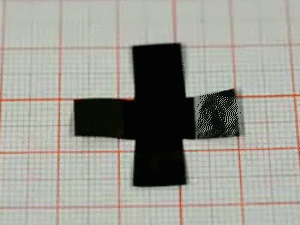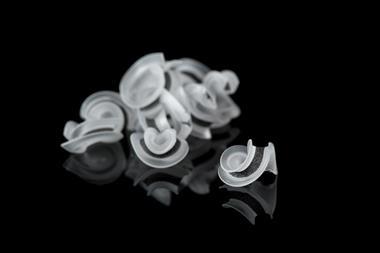Self-folding paper devices remotely controlled by light show potential as artificial muscles

Scientists in China have developed a graphene-based paper which can fold itself into predesigned shapes when exposed to light or gentle heat. The material, which is created from graphene oxide, can also ‘walk’ across a table and turn a corner. Potential applications of the material include sensors, artificial muscles and robotics.
Active materials have faced challenges in making the step from the lab to the real world. Polymer materials often suffer from poor stability, complex preparation and impractical operating conditions. Hongzhi Wang and colleagues at Donghua University, China, have found that using graphene avoids these problems. The elastic, mechanical and light-absorbing properties of graphene offer the advantages of fast response time, efficient output and remote controlled behaviour. The material also operates in physiological conditions, increasing the number of potential applications.
To produce the mechanical folding effect, graphene oxide-polydopamine (GO-PDA) layers are deposited in a pattern onto a graphene oxide base. The GO-PDA layers contain water absorbed from the environment. Shining infra-red or laser light onto the paper led to the water evaporating and causes the layers to shrink, bending the paper into the designed shape. When the light is extinguished the GO-PDA quickly reabsorbs water and the paper unfolds. A hand shaped device can be used to grip and release objects, and a strip of the material can mimic the locomotion of a caterpillar when the light is repeatedly flashed on and off. ‘We thought it would be more interesting that an origami device not only folds itself but also can move on its own, like an origami crane can fly or an origami dragon can walk,’ Wang explains.
The inspiration for this work came from from nature. ‘Many plants, such as Mimosa pudica, can sensitively close their leaflets when stimulated by the environment,’ Wang says. ‘This inspired us to see whether we can simulate this behaviour and fabricate an artificial intelligent material.’
‘This work has the appeal of being simple to implement and actuates the films in a reversible manner,’ comments Michael Dickey, an expert in fabrication of nanomaterials at North Carolina State University, US. ‘There is interest in materials that can be stored flat and then induced into some useful shape, such as a gripper or an actuator, using simple triggers such as light.’
Wang has great hopes for the future of this technology. ‘We believe this work could bring smart clothes which could change shape and style in response to body temperature, environmental changes, or other gentle simulations.’ His ambitions even stretch to integrating the paper into solar cells to build self-folding panels.
References
J Mu et al, Sci. Adv., 2015, DOI: 10.1126/sciadv.1500533












No comments yet